The Use of Nuclear Magnetic Resonance Spectroscopy (NMR) to Characterize Bitumen Used in the Road Pavements Industry: A Review
Abstract
1. Introduction
1.1. Background on Bitumen Used in Road Pavements
1.2. Importance of Characterizing Bitumen
- Asphaltenes are not defined by their molecular structure, but rather on the basis of the procedure required to extract them from heavy oils [15];
- Bitumen is a not well-defined mixture of constituents, so different methods of analysis exist where solvents are added to bitumen to determine its chemical properties.
1.3. Role of Nuclear Magnetic Resonance (NMR) Spectroscopy in Bitumen Characterization
2. Nuclear Magnetic Resonance (NMR) Spectroscopy
2.1. Basic Principles of NMR Spectroscopy
2.2. Relaxometry Analysis
2.3. Diffusometry
3. Types of NMR Employed in Bitumen Characterization
3.1. One Dimensional NMR
3.2. Two-Dimensional NMR
3.3. FFC-DNP Fast Field Cycling Dynamic Nuclear Polarization
3.4. DOSY
4. Case Studies on Bitumen Characterization Using NMR
4.1. Bitumen Emulsion and Analysis of Physico-Mechanical Properties
- 1H NMR
- PFGSE-NMR
- PFGSE-NMR combined with 1D-imaging
4.2. Bitument Content and Molecular Composition Determination
- LF-NMR Relaxometry
- FID and CPMG-NMR
- TD-NMR
- TLC and 1H-NMR
- 2D NMR
- Combined NMR-FTIR
4.3. Bitumen Ageing
- FT-NMR-SDC
- ILT NMR
5. Comparison between NMR Techniques Used in Bitumen Analysis
6. Challenges and Limitations
7. Future Directions
8. Conclusions
Author Contributions
Funding
Institutional Review Board Statement
Informed Consent Statement
Data Availability Statement
Conflicts of Interest
Abbreviations
| APGSTE | alternating pulsed gradient stimulated echo |
| CPMG | Carr–Purcell–Meilboom–Gill |
| D | (self)-diffusion coefficient |
| DNP | Dynamic Nuclear Polarization |
| DOSY | Diffusion ordered 2D-NMR spectroscopy |
| ESEM | Environmental Scanning Electron Microscopy |
| FID | free induction decay |
| FT-IR | Fourier-Transform infrared spectroscopy |
| FT-NMR-SDC | Fourier Transform NMR Self-Diffusion Coefficient |
| GC | gas chromatography |
| GPC | gel permeation chromatography |
| HMBC | heteronuclear multiple bond coherence |
| ILT | Inverse Laplace Transform |
| LF-NMR | Low Field NMR |
| NMR | Nuclear Magnetic Resonance |
| NMRD | nuclear magnetic relaxation dispersion |
| PAV | Pressure Aging Vessel |
| PFGSE | Pulsed Field Gradient Stimulated Echo |
| PGSE | pulsed gradient spin echo |
| RAP | Reclaimed Asphalt Pavement |
| REXSY | (T2-T2) relaxation exchange pulse sequence |
| RTFO | Rolling Thin Film Oven |
| SARA | Saturates, Aromatics, Resins, Asphaltenes |
| SBR | Styrene Butadiene Rubber |
| SGE | Simultaneous Gaussian-Exponential |
| TD-NMR | Time Domain NMR |
| TLC | Thin Layer Chromatography |
References
- Petrauskas, D.; Saleem, U. The Shell Bitumen Handbook; Read, J., Whiteoak, D., Eds.; Thomas Telford.: London, UK, 2003; p. 29. ISBN 072773220X. [Google Scholar]
- Paliukaitė, M.; Vaitkus, A.; Zofka, A. Evaluation of bitumen fractional composition depending on the crude oil type and production technology. In Proceedings of the 9th International Conference “ENVIRONMENTAL ENGINEERING”, Vilnius, Lithuania, 22–23 May 2014. [Google Scholar]
- Kennedy, T.W.; Huber, G.A.; Harrigan, E.T.; Cominsky, R.J.; Hughes, C.S.; Von Quintus, H.; Moulthrop, J.S. Superior Performing Asphalt Pavements (Superpave). In The Product of the SHRP Asphalt Research Program; National Research Council: Washington, DC, USA, 1994. [Google Scholar]
- Yoon, S.; Durgashanker Bhatt, S.; Lee, W.; Lee, H.Y.; Jeong, S.Y.; Baeg, J.O.; Wee Lee, C. Separation and characterization of bitumen from Athabasca oil sand. Korean J. Chem. Eng. 2009, 26, 64–71. [Google Scholar] [CrossRef]
- Thurston, R.R.; Knowles, E.C. Asphalt and Its Constituents. Oxidation at Service Temperatures. Ind. Eng. Chem. 1941, 33, 320–324. [Google Scholar] [CrossRef]
- Calandra, P.; Caputo, P.; De Santo, M.; Todaro, L.; Liveri, V.; Oliviero, C. Effect of additives on the structural organization of asphaltene aggregates in bitumen. Constr. Build. Mater. 2018, 199, 288–297. [Google Scholar] [CrossRef]
- Korb, J.-P.; Louis-Joseph, A.; Benamsili, L. Probing structure and dynamics of bulk and confined crude oils by multiscale NMR spectroscopy, diffusometry, and relaxometry. J. Phys. Chem. B 2013, 117, 7002–7014. [Google Scholar] [CrossRef]
- Calandra, P.; Longo, A.; Ruggirello, A.; Turco Liveri, V. Physico-Chemical Investigation of the State of Cyanamide Confined in AOT and Lecithin Reversed Micelles. J. Phys. Chem. B 2004, 108, 8260–8268. [Google Scholar] [CrossRef]
- Calandra, P.; Giordano, C.; Ruggirello, A.; Turco Liveri, V. Physicochemical investigation of acrylamide solubilization in sodium bis (2-ethylhexyl) sulfosuccinate and lecithin reversed micelles. J. Colloid Interface Sci. 2004, 277, 206–214. [Google Scholar] [CrossRef] [PubMed]
- Calandra, P.; Marco, G.D.; Ruggirello, A.; Liveri, V.T. Physico-chemical investigation of nanostructures in liquid phases: Nickel chloride ionic clusters confined in sodium bis (2-ethylhexyl) sulfosuccinate reverse micelles. J. Colloid Interface Sci. 2009, 336, 176–182. [Google Scholar] [CrossRef]
- Longo, A.; Calandra, P.; Casaletto, M.P.; Giordano, C.; Venezia, A.M.; Liveri, V.T. Synthesis and physico-chemical characterization of gold nanoparticles softly coated by AOT. Mater. Chem. Phys. 2006, 96, 66–72. [Google Scholar] [CrossRef]
- Lesueur, D. The colloidal structure of bitumen: Consequences on the rheology and on the mechanisms of bitumen modification. Adv. Colloid Interface Sci. 2009, 145, 42–82. [Google Scholar] [CrossRef] [PubMed]
- Petersen, J.C. A Review of the Fundamentals of Asphalt Oxidation: Chemical, Physicochemical, Physical Property, and Durability Relationships; Transportation Research Circular; Transportation Research Board: Washington, DC, USA, 2009. [Google Scholar]
- Rozeveld, S.; Shin, E.; Bhurke, A.; France, L.; Drzal, L. Network morphology of straight and polymer modified asphalt cements. Microsc. Res. Technol. 1997, 38, 529–543. [Google Scholar] [CrossRef]
- Altgelt, K.H.; Boduszynski, M.M. Compositional Analysis: Dream and Reality. In Composition and Analysis of Heavy Petroleum Fractions; Marcel Dekker: New York, NY, USA, 1994; pp. 9–39. [Google Scholar]
- Zenke, G. Zum Löseverhalten von “Asphaltenen”: Anwendung von Löslichkeitsparameter-Konzepten auf Kolloidfraktionen Schwerer Erdöl Produkte. Ph.D. Thesis, Technical University of Clausthal, Clausthal-Zellerfeld, Germany, 1989. [Google Scholar]
- Hurley, G.C.; Prowell, B.D. Evaluation of potential processes for use in warm mix asphalt. J. Assoc. Asph. Paving Technol. 2006, 75, 41–90. [Google Scholar]
- Silva, H.M.R.D.; Oliveira, J.R.M.; Ferreira, C.I.G.; Pereira, P.A.A. Assessment of the performance of warm mix asphalts in road pavements. Int. J. Pavement Res. Technol. 2010, 3, 119–127. [Google Scholar]
- Hakseo, K.; Soon-Jae, L. Rheology of warm mix asphalt binders with aged binders. Constr. Build. Mater. 2011, 25, 183–189. [Google Scholar]
- Calandra, P.; Caschera, D.; Liveri, V.T.; Lombardo, D. How self-assembly of amphiphilic molecules can generate complexity in the nanoscale. Colloids Surf. A Physicochem. Eng. Asp. 2015, 484, 164–183. [Google Scholar] [CrossRef]
- Jäger, A.; Lackner, R.; Eisenmenger-Sittner, C.; Blab, R. Identification of Microstructural components of bitumen by means of Atomic Force microscopy (AFM). Proc. PAMM Appl. Math. Mech. 2004, 4, 400–401. [Google Scholar] [CrossRef]
- Handle, F.; Füssl, J.; Neudl, S.; Grossegger, D.; Eberhardsteiner, L.; Hofko, B.; Hospodka, M.; Blab, R.; Grothe, H. The bitumen microstructure: A fluorescent approach. Mater. Struct. 2016, 49, 167–180. [Google Scholar] [CrossRef]
- Zhang, F.; Hu, C.; Zhang, Y. Influence of poly (phosphoric acid) on the properties and structure of ethylene-vinyl acetate-modified bitumen. J. Appl. Polym. Sci. 2018, 135, 46553. [Google Scholar] [CrossRef]
- Xu, X.; Yu, J.; Xue, L.; Zhang, C.; He, B.; Wu, M. Structure and performance evaluation on aged SBS modified bitumen with bi- or tri- epoxy reactive rejuvenating system. Constr. Build. Mater. 2017, 151, 479–486. [Google Scholar] [CrossRef]
- Tanaka, R.; Sato, E.; Hunt, J.E.; Winans, R.E.; Sato, S.; Takanohashi, T. Characterization of Asphaltene Aggregates Using X-ray Diffraction and Small-Angle X-ray Scattering. Energy Fuels 2004, 18, 1118–1125. [Google Scholar] [CrossRef]
- Kuang, D.; Ye, Z.; Yang, L.; Iu, N.; Lu, Z.; Che, H. Effect of Rejuvenator Containing Dodecyl Benzene Sulfonic Acid (DBSA) on Physical Properties, Chemical Components, Colloidal Structure and Micro-Morphology of Aged Bitumen. Materials 2018, 11, 1476. [Google Scholar] [CrossRef]
- Yen, T.F.; Erdman, J.G.; Pollak, S.S. Investigation of the Structure of Petroleum Asphaltenes by X-ray Diffraction. Anal. Chem. 1961, 33, 1587–1594. [Google Scholar] [CrossRef]
- Sharma, B.K.; Adhavaryu, A.; Liu, Z.; Erhan, S.Z. Chemical modification of vegetable oils for lubrificant application. J. Am. Oil Chem. Soc. 2006, 83, 129–136. [Google Scholar] [CrossRef]
- Thyrion, F. Asphalt Oxidation. In Asphaltenes and Asphalts: Development in Petroleum Science 2000; Elsevier: New York, NY, USA, 2000; pp. 445–474. [Google Scholar]
- Ayorinde, J.O.; Ehinola, O.; Durogbitan, A. A Review of the Application of Nuclear Magnetic Resonance in Petroleum Industry. Int. J. Geosci. 2020, 11, 145–169. [Google Scholar] [CrossRef]
- Galeev, R.I.; Sakharov, B.V.; Khasanova, N.M.; Volkov, V.Y.; Fazlyyyakhmatov, M.G.; Shamanov, I.N.; Emelianov, D.A.; Kozlova, E.V.; Petrashov, O.V.; Varfolomeev, M.A. Novel low-field NMR method for characterization content and SARA composition of bitumen in rocks. J. Pet. Sci. Eng. 2022, 214, 110486. [Google Scholar] [CrossRef]
- Oliviero Rossi, C.; Caputo, P.; De Luca, G.; Maiuolo, L.; Eskandarsefat, S.; Sangiorgi, C. 1H-NMR Spectroscopy: A Possible Approach to Advanced Bitumen Characterization for Industrial and Paving Applications. Appl. Sci. 2018, 8, 229. [Google Scholar] [CrossRef]
- Porto, M.; Angelico, R.; Caputo, P.; Abe, A.A.; Teltayev, B.; Rossi, C.O. The Structure of Bitumen: Conceptual Models and Experimental Evidences. Materials 2022, 15, 905. [Google Scholar] [CrossRef]
- Parlov Vuković, J.; Novak, P.; Jednačak, T. NMR spectroscopy as a tool for studying asphaltene composition. Croat. Chem. Acta 2019, 92, 323–329. [Google Scholar] [CrossRef]
- Morgan, V.G.; Sad, C.M.; Leite, J.S.; Castro, E.R.; Barbosa, L.L. Time domain NMR: An alternative for study of the asphaltenes precipitated in petroleum. Magn. Reson. Chem. 2022, 60, 996. [Google Scholar] [CrossRef]
- ASTM D6560; Standard Test Method for Determination of Asphaltenes (Heptane Insolubles) in Crude Petroleum and Petroleum Products. ASTM International: West Conshohocken, PA, USA, 2022.
- Chinelatto Júnior, L.S.; Cabral De Menezes, S.M.; Honorato, H.D.A.; De Oliveira, M.C.K.; Marques, L.C.D.C. Diffusion-ordered spectroscopy nuclear magnetic resonance as an alternative technique to improve asphaltene characterization. Energy Fuels 2018, 32, 2793–2800. [Google Scholar] [CrossRef]
- Rakhmatullin, I.; Efimov, S.; Tyurin, V.; Al-Muntaser, A.; Klimovitskii, A.; Varfolomeev, M.; Klochkov, V. Application of High Resolution NMR (1H and 13C) and FTIR Spectroscopy for Characterization of Light and Heavy Crude Oils. J. Pet. Sci. Eng. 2018, 168, 256–262. [Google Scholar] [CrossRef]
- Werkovits, S.; Bacher, M.; Theiner, J.; Rosenau, H. Grothe. Multi-spectroscopic characterization of bitumen and its polarity-based fractions. Constr. Build. Mat. 2022, 352, 128992. [Google Scholar] [CrossRef]
- Yang, K.; Connolly, P.R.; Li, M.; Seltzer, S.J.; McCarty, D.K.; Mahmoud, M.; El-Husseiny, A.; May, E.F.; Johns, M.L. Shale rock core analysis using NMR: Effect of bitumen and water content. J. Pet. Sci. Eng. 2020, 95, 107847. [Google Scholar] [CrossRef]
- Song, Y.Q.; Kausik, R. NMR application in unconventional shale reservoirs—A new porous media research frontier. Prog. Nucl Magn. Reson. Spectrosc. 2019, 112–113, 17–33. [Google Scholar] [CrossRef] [PubMed]
- Blinder, R.; Champenois, J.-B.; Leclerc, A.; Poulesquen, A.; Guillermo, A.; Lautru, J.; Podor, R.; Bardet, M. NMR 1D-Imaging of Water Ifiltration into Porous Bitumen-Salt Matrices: The Effect of Salt Solubility. J. Phys. Chem. C 2019, 123, 27105–27115. [Google Scholar] [CrossRef]
- Teltayev, B.B.; Seilkhanov, T.M. NMR-Spectroscopy Determination of Fragmentary Composition of Bitumen and its Components. Eurasian Chem. Technol. 2018, 20, 153–158. [Google Scholar] [CrossRef]
- Mutina, A.R.; Hürlimann, M.D. Correlation of Transverse and Rotational Diffusion Coefficient: A Probe of Chemical Composition in Hydrocarbon Oils. J. Phys. Chem. A 2008, 112, 3291–3301. [Google Scholar] [CrossRef]
- Loise, V.; Caputo, P.; Porto, M.; Teltayev, B.; Angelico, C.; Oliviero, R. Unravelling the role of a green rejuvenator agent in contrasting the aging effect on bitumen: A dynamics rheology, nuclear magnetic relaxometry and self-diffusion study. Colloids Surf. A 2020, 603, 125182. [Google Scholar] [CrossRef]
- Porto, M.; Angelico, R.; Calandra, P.; Loise, V.; Abe, A.A.; Rossi, C.O.; Caputo, P. NMR Self-Diffusion and Transverse Relaxation Time in Bitumen: The Effect of Aging. Chem. Phys. Chem. 2023, 24, e202300217. [Google Scholar] [CrossRef]
- Diehl, B. Principles in NMR spectroscopy. In NMR Spectroscopy in Pharmaceutical Analysis; Holzgrabe, U., Wawer, I., Diehl, B.B.T., Eds.; Elsevier: Amsterdam, The Netherlands, 2008; pp. 1–41. [Google Scholar]
- Hahn, E.L. Nuclear induction due to free larmor precession. Phys. Rev. 1950, 77, 297–298. [Google Scholar] [CrossRef]
- Vold, R.L.; Waugh, J.S.; Klein, M.P.; Phelps, D.E. Measurement of spin relaxation in complex systems. J. Chem. Phys. 1968, 48, 3831–3832. [Google Scholar] [CrossRef]
- Hahn, E.L. Spin echoes. Phys. Rev. 1950, 80, 580–594. [Google Scholar] [CrossRef]
- Wahba, G.; Wang, Y. When is the optimal regularization parameter insensitive to the choice of the loss function? Commun. Stat Theory Methods 1990, 19, 1685–1700. [Google Scholar] [CrossRef]
- Willis, S.A.; Stait-Gardner, T.; Torres, A.M.; Price, W.S. Fundamentals of diffusion measurements using NMR. In Diffusion NMR of Confined Systems: Fluid Transport in Porous Solids and Heterogeneous Materials; Valiullin, R., Ed.; The Royal Society of Chemis-try: Cambridge, UK, 2016; pp. 16–51. [Google Scholar]
- Mazumder, A.; Dubey, D.K. Nuclear magnetic resonance (NMR) spectroscopy. In Reference Module in Chemistry, Molecular Sciences and Chemical Engineering; Elsevier: Amsterdam, The Netherlands, 2013. [Google Scholar] [CrossRef]
- Stejskal, E.O.; Tanner, J.E. Spin diffusion measurements: Spin echoes in the presence of a time-dependent field gradient. J. Chem. Phys. 1965, 42, 288–292. [Google Scholar] [CrossRef]
- Cotts, R.; Hoch, M.J.; Sun, T.; Markert, J. Pulsed field gradient stimulated echo methods for improved NMR diffusion measurements in heterogeneous systems. J. Magn. Reson. 1989, 83, 252–266. [Google Scholar] [CrossRef]
- Varanda, C.; Portugal, I.; Ribeiro, J.; Silva, C.M.; Silva, A.M.S. NMR Spectroscopy in Bitumen Characterization. In Analytical Characterization Methods for Crude Oil and Related Products. Shukla, A.K., Ed.; John Wiley & Sons Ltd.: Hoboken, NJ, USA, 2018; pp. 141–161. [Google Scholar] [CrossRef]
- Venkataramanan, L.; Song, Y.-Q.; Hurlimann, M.D. Solving Fredholm integrals of the first kind with tensor product structure in 2 and 2.5 dimensions. IEEE Trans. Signal Process. 2002, 50, 1017–1026. [Google Scholar] [CrossRef]
- Mitchell, J.; Griffith, J.D.; Collins, J.H.P.; Sederman, A.J.; Gladden, L.F.; Johns, M.L. Validation of NMR relaxation exchange time measurements in porous media. J. Chem. Phys. 2007, 127, 234701. [Google Scholar] [CrossRef]
- Mal, T.K. NMR Spectroscopy Analysis of Asphaltenes. Energy Fuels 2019, 33, 10391–10414. [Google Scholar] [CrossRef]
- Mitchell, J.; Chandrasekera, T.C.; Gladden, L.F. Numerical estimation of relaxation and diffusion distributions in two dimensions. Prog. Nucl. Magn. Reson. Spectrosc. 2012, 62, 34–50. [Google Scholar] [CrossRef]
- Gizatullin, B.; Gafurov, M.R.; Vakhin, A.V.; Rodionov, A.; Mamin, G.; Orlinskii, S.; Mattea, S. Stapf. Native Vanadyl Complexes in Crude Oil as Polarizing Agents for in Situ Proton Dynamic Nuclear Polarization. Energy Fuels 2019, 33, 10923–10932. [Google Scholar] [CrossRef]
- Gizatullin, B.; Gafurov, M.; Rodionov, A.; Mamin, G.; Mattea, C.; Stapf, S. Orlinskii. Proton-radical interaction in crude oil—A combined NMR and EPR study. Energy Fuels 2018, 32, 11261–11268. [Google Scholar] [CrossRef]
- Morris, K.F.; Johnson, C.S. Diffusion-ordered two-dimensional nuclear magnetic resonance spectroscopy. J. Am. Chem. Soc. 1992, 114, 3139–3141. [Google Scholar] [CrossRef]
- Yuan, M.; Xu, W.; Yang, Y.; Li, S.; Yang, H.; Gao, J.; Jiang, H.; Yang, M. Diffusion-Ordered Spectroscopy (DOSY) as a Powerful NMR Method to Investigate Molecular Mobilities and Intermolecular Interactions in Complex Oil Mixtures. Chem. Phys. Chem. 2023, 24, e202300587. [Google Scholar] [CrossRef] [PubMed]
- Durand, E.; Clemancey, M.; Quoineaud, A.A.; Verstraete, J.; Espinat, D.; Lancelin, J.M. 1H Diffusion-Ordered Spectroscopy (DOSY) Nuclear Magnetic Resonance (NMR) as a Powerful Tool for the Analysis of Hydrocarbon Mixtures and Asphaltenes. Energy Fuels 2008, 22, 2604–2610. [Google Scholar] [CrossRef]
- Durand, E.; Clemancey, M.; Lancelin, J.-M.; Verstraete, J.; Espinat, D.; Quoineaud, A.-A. Aggregation states of asphaltenes: Evidence of Two chemical behaviors by 1H diffusion-ordered spectroscopy nuclear magnetic resonance. J. Phys. Chem. C 2009, 113, 16266–16276. [Google Scholar] [CrossRef]
- Lisitza, N.V.; Freed, D.E.; Sen, P.N.; Song, Y.-Q. Study of asphaltene nanoaggregation by nuclear magnetic resonance (NMR). Energy Fuels 2009, 23, 1189–1193. [Google Scholar] [CrossRef]
- Silva Oliveira, E.C.; Neto, Á.C.; Júnior, V.L.; Castro, E.V.R.; Menezes, S.M.C. Study of Brazilian asphaltene aggregation by nuclear magnetic resonance spectroscopy. Fuel 2014, 117, 146–151. [Google Scholar] [CrossRef]
- Vorapalawut, N.; Nicot, B.; Louis-Joseph, A.; Korb, J.-P. Probing Dynamics and Interaction of Maltenes with Asphaltene Aggregates in Crude Oils by Multiscale NMR. Energy Fuels 2015, 29, 4911–4920. [Google Scholar] [CrossRef]
- Parlov Vuković, J.; Hrenar, T.; Novak, P.; Friedrich, M.; Plavec, J. New Multiway Model for Identification of Crude Oil and Asphaltene Origin Based on Diffusion-Ordered Nuclear Magnetic Resonance Spectroscopy. Energy Fuels 2017, 31, 8095–8101. [Google Scholar] [CrossRef]
- Vuković, J.P.; Novak, P.; Jednačak, T.; Kveštak, M.; Kovačević, D.; Smrečki, V.; Mikulandra, I.; Ibrahimpašić, M.D.; Glanzer, S.; Zangger, K. Magnetic field influence on asphaltene aggregation monitored by diffusion NMR spectroscopy: Is aggregation reversible at high magnetic fields? J. Disper. Sci. Technol. 2020, 41, 179–187. [Google Scholar] [CrossRef]
- Weber, D.; Mitchell, J.; McGregor, J.; Gladden, L.F. Comparing strengths of surface interactions for reactants and solvents in porous catalysts using two-dimensional NMR relaxation correlations. J. Phys Chem C 2009, 113, 6610–6615. [Google Scholar] [CrossRef]
- Korb, J.P.; Vorapalawut, N.; Nicot, B.; Bryant, R.G. Relation and Correlation between NMR Relaxation Times, Diffusion Coefficients, and Viscosity of Heavy Crude Oils. J. Phys. Chem. C 2015, 119, 24439–24446. [Google Scholar] [CrossRef]
- Fleury, M.; Romero-Sarmiento, M. Characterization of shales using T1–T2 NMR maps. J. Pet. Sci. Eng. 2016, 137, 55–62. [Google Scholar] [CrossRef]
- Cheng, Y.; Chen, S.; Eid, M.; Hursan, G.; Ma, S. Determination of permeability from NMR T1/T2 ratio in carbonates. In Proceedings of the SPWLA 58th Annual Logging Symposium, Oklahoma, OK, USA, 17–21 June 2017. [Google Scholar]
- Valori, A.; Hursan, G. Laboratory and downhole wettability from NMR T1/T2 ratio. Petrophysics 2017, 58, 352–365. [Google Scholar]
- Shikhov, I.; Thomas, D.; Arns, C.H. On the optimum ageing time—Magnetic resonance study of asphaltene adsorption dynamics in sandstone rock. Energy Fuels 2019, 33, 8184–8201. [Google Scholar] [CrossRef]
- Guo, J.; Xie, R.; Xiao, L.; Liu, M.; Gao, L. Nuclear magnetic resonance T1–T2 spectra in heavy oil reservoirs. Energies 2019, 12, 2415. [Google Scholar] [CrossRef]
- Luo, Z.-X.; Paulsen, J.; Song, Y.-Q. Robust determination of surface relaxivity from nuclear magnetic resonance DT2 measurements. J. Magn. Reson. 2015, 259, 146–152. [Google Scholar] [CrossRef]
- Benamsili, L.; Korb, J.-P.; Hamon, G.; Louis-Joseph, A.; Bouyssiere, B.; Zhou, H.; Bryant, R.G. Multi-dimensional nuclear magnetic resonance characterizations of dynamics and saturations of brine/crude oil/mud filtrate mixtures confined in rocks: The role of asphaltene. Energy Fuels 2014, 28, 1629–1640. [Google Scholar] [CrossRef]
- Wang, H.; Alvarado, V.; McLaughlin, J.F.; Bagdonas, D.A.; Kaszuba, J.P.; Campbell, E.; Grana, D. Low-field nuclear magnetic resonance characterization of carbonate and sandstone reservoirs from rock spring uplift of wyoming. J. Geophys. Res. Solid Earth 2018, 123, 7444–7460. [Google Scholar] [CrossRef]
- Wang, J.; Xiao, L.; Liao, G.; Zhang, Y.; Guo, L.; Arns, C.H.; Sun, Z. Theoretical investigation of heterogeneous wettability in porous media using NMR. Sci. Rep. 2018, 8, 13450. [Google Scholar] [CrossRef]
- Sakthivel, S.; Elsayed, M. Enhanced oil recovery by spontaneous imbibition of imidazolium based ionic liquids on the carbonate reservoir. J. Mol. Liq. 2021, 340, 117301. [Google Scholar] [CrossRef]
- Johnson, D.L.; Schwartz, L.M. Analytic theory of two-dimensional NMR in systems with coupled macro- and micropores. Phys. Rev. E 2014, 90, 032407. [Google Scholar] [CrossRef] [PubMed]
- Shikhov, I.; Li, R.; Arns, C.H. Relaxation and relaxation exchange NMR to characterise asphaltene adsorption and wettability dynamics in siliceous systems. Fuel 2018, 220, 692–705. [Google Scholar] [CrossRef]
- Mankinen, O.; Zhivonitko, V.V.; Selent, A.; Mailhiot, S.; Komulainen, S.; Prisle, N.L.; Ahola, S.; Telkki, V.-V. Ultrafast diffusion exchange nuclear magnetic resonance. Nat. Commun. 2020, 11, 3251. [Google Scholar] [CrossRef]
- Andrei, F.; Hilde, S.; Johan, B.; Antzutkin, O.N. Dynamics and Structure of a Bitumen Emulsion as Studied by 1H NMR Diffusometry. ACS Omega 2023, 8, 36534–36542. [Google Scholar] [CrossRef]
- Caputo, P.; Porto, M.; Loise, V.; Teltayev, B.; Rossi, C.O. Analysis of mechanical performance of bitumen modified with waste plastic and rubber (SBR) additives by rheology and PGSE NMR experiments. Eurasian Chem. Technol. J. 2019, 21, 235–239. [Google Scholar] [CrossRef]
- Jiang, T.; Hirasaki, G.; Miller, C.; Moran, K.; Fleury, M. Diluted Bitumen Water-in-Oil Emulsion Stability and Characterization by Nuclear Magnetic Resonance (NMR) Measurements. Energy Fuels 2007, 21, 1325–1336. [Google Scholar] [CrossRef]
- Johns, M.L. NMR studies of emulsions. Curr. Opin. Colloid Interface Sci. 2009, 14, 178–183. [Google Scholar] [CrossRef]
- Washburn, K.E.; Anderssen, E.; Vogt, S.J.; Seymour, J.D.; Birdwell, J.E.; Kirkland, C.M.; Codd, S.L. Simultaneous Gaussian and exponential inversion for improved analysis of shales by NMR relaxometry. J. Magn. Reson. 2015, 250, 7–16. [Google Scholar] [CrossRef]
- Le Feunteun, S.; Diat, O.; Guillermo, A.; Poulesquen, A.; Podor, R. NMR 1D-imaging of water infiltration into mesoporous matrices. Magn. Reson. Imaging 2011, 29, 443–455. [Google Scholar] [CrossRef]
- Elsayed, M.; Isah, A.; Hiba, M.; Hassan, A.; Al-Garadi, K.; Mahmoud, M.; El-Husseiny, A.; Radwan, A.E. A review on the applications of nuclear magnetic resonance (NMR) in the oil and gas industry: Laboratory and field-scale measurements. J. Pet. Explor. Prod. Technol. 2022, 12, 2747–2784. [Google Scholar] [CrossRef]
- ASTM D4124; Standard Test Method for Separation of Asphalt into Four Fractions. ASTM International: West Conshohocken, PA, USA, 2012.
- Mirotchnik, K.; Allsopp, K.; Kantzas, A.; Marentette, D. University Technologies International Inc. Determination of Oil and Water Compositions of Oil/Water Emulsions Using Low Field NMR Relaxometry. U.S. Patent 6,794,864, 21 September 2004. [Google Scholar]
- Allsopp, K.; Wright, I.; Lastockin, D.; Mirotchnik, K.; Kantzas, A. Determination of Oil and Water Compositions of Oil/Water Emulsions Using Low Field NMR Relaxometry. Journal of Canadian Petroleum Technology. J Can. Petrol. Technol. 2001, 40. [Google Scholar] [CrossRef]
- Zielinski, L.; Saha, I.; Freed, D.E.; Hurlimann, M.D. Probing Asphaltene Aggregation in Native Crude Oils with Low-Field NMR. Langmuir 2010, 26, 5014–5021. [Google Scholar] [CrossRef]
- Zielinski, L.; Hurlimann, M.D. Nuclear Magnetic Resonance Dispersion of Distributions as a Probe of aggregation in Crude Oils. Energy Fuels 2011, 25, 5090–5099. [Google Scholar] [CrossRef]
- Volkov, V.Y.; Sakharov, B.V.; Khasanova, N.M.; Nurgaliev, D.K. Analysis of the composition and properties of heavy oils in situ by Low Field NMR relaxation method. Georesources 2018, 20, 308–323. [Google Scholar] [CrossRef]
- Volkov, V.Y.; Al-Muntaser, A.A.; Varfolomeev, M.A.; Khasanova, N.M.; Sakharov, B.V.; Suwaid, M.A.; Djimasbe, R.; Galeev, R.I.; Nurgaliev, D.K. Low-field NMR-relaxometry as fast and simple technique for in-situ determination of SARA-composition of crude oils. J. Petrol. Sci. Eng. 2021, 196, 107990. [Google Scholar] [CrossRef]
- Kamar, H.; Ghosh, S.; Paproski, R.E.; Krygsman, P.; Bhalla, B.; Syncrude Canada Ltd.; Bruker Ltd.; Bruker Corp. Simultaneous Determination of Bitumen and Water Content in Oil Sand and Oil Sand Extraction Process Samples Using Low-Field Time-Domain NMR. U.S. Patent 8,547,096, 1 October 2013. [Google Scholar]
- Khavandi Khiavi, A.; Ghanbari, A.; Ahmadi, E. Evaluation of Poly 2-Hydroxyethyl Methacrylate—Modified Bitumen Aging Using NMR and FTIR Techniques. J. Transp. Eng. Part B Pavements 2021, 147, 04020087. [Google Scholar] [CrossRef]
- Rossi, C.O.; Caputo, P.; Loise, V.; Ashimova, S.; Teltayev, B.; Sangiorgi, C. A New Green Rejuvenator: Evaluation of Structural Changes of Aged and Recycled Bitumens by Means of Rheology and NMR. © RILEM 2019. In RILEM 252-CMB; 2018 RILEM Bookseries 20; Poulikakos, L.D., Ed.; Springer: Cham, Switzerland, 2019; pp. 177–182. [Google Scholar] [CrossRef]
- Caputo, P.; Loise, V.; Crispini, A.; Sangiorgi, C.; Scarpelli, F.; Rossi, C.O. The efficiency of bitumen rejuvenator investigated through Powder X-ray Diffraction (PXRD) analysis and T2-NMR spectroscopy. Colloids Surf. A 2019, 571, 50–54. [Google Scholar] [CrossRef]
- Caputo, P.; Loise, V.; Ashimova, S.; Teltayev, B.; Vaiana, R.; Oliviero, R. Inverse Laplace Transform (ILT) NMR: A powerful tool to differentiate a real rejuvenator and a softener of aged bitumen. Colloids Surf. A 2019, 574, 154–161. [Google Scholar] [CrossRef]
- Gwinner, B.; Sercombe, J.; Tiffreau, C.; Simondi-Teisseire, B.; Felines, I.; Adenot, F. Modelling of bituminized radioactive waste leaching. Part II: Experimental validation. J. Nucl. Mater. 2006, 349, 107–118. [Google Scholar] [CrossRef]
- Mirotchnik, K.; Allsopp, K.; Kantzas, A.; Marentette, D. Quantification of Bitumen Using NMR. Available online: https://patents.google.com/patent/CA2325348C/en (accessed on 25 June 2024).
- Khelil, I.; Al-Muntaser, A.; Varfolomeev, M.A.; Hail Hakimi, M.; Suwaid, M.A.; Saeed, S.A.; Nurgaliev, D.K.; Al-Fatesh, A.S.; Osman, A. I Innovations in Crude-Oil Characterization: A Comprehensive Review of LF-NMR Applications. Energies 2024, 17, 3416. [Google Scholar] [CrossRef]
- Kanai, N.; Willis, S.A.; Kawamura, I.; Price, W.S. Droplet size distribution of oil-in-water Pickering emulsions stabilized by cellulose nanofibers using restricted diffusion NMR. J. Mol. Liq. 2024, 403, 124793. [Google Scholar] [CrossRef]
- Caputo, P.; Shaikhah, D.; Porto, M.; Loise, V.; De Santo, M.P.; Oliviero Rossi, C. NMR diffusiometry spectroscopy a novel technique for monitoring the micro-modifications in bitumen ageing. Appl. Sci. 2020, 10, 5409. [Google Scholar] [CrossRef]
- Ok, S.; Mahmoodinia, M.; Rajasekaran, N.; Sabti, M.A.; Lervik, A.; van Erp, T.S.; Cabriolu, R. Molecular Structure and Solubility Determination of Asphaltenes. Energy Fuels 2019, 33, 8259–8270. [Google Scholar] [CrossRef]
- Shishkova, I.; Stratiev, D.; Kolev, I.V.; Nenov, S.; Nedanovski, D.; Atanassov, K.; Ivanov, V.; Ribagin, S. Challenges in Petroleum Characterization-A Review. Energies 2022, 15, 7765. [Google Scholar] [CrossRef]
- Pitawala, P.D. Teal. Bayesian NMR petrophysical characterization. J. Magn. Res. 2024, 362, 107663. [Google Scholar] [CrossRef]
- Filgueiras, P.R.; Portela, N.A.; Silva, S.R.; Castro, E.V.; Oliveira, L.M.; Dias, J.C.; Neto, A.C.; Romao, W.; Poppi, R.J. Determination of saturates, aromatics, and polars in crude Oil by 13C NMR and support vector regression with variable selection by genetic algorithm. Fuel 2016, 30, 1972–1978. [Google Scholar] [CrossRef]
- Duarte, L.M.; Filgueiras, P.R.; Silva, S.R.; Dias, J.C.; Oliveira, L.M.; Castro, E.V.; de Oliveira, M.A. Determination of some physicochemical properties in Brazilian crude oil by 1H NMR spectroscopy associated to chemometric approach. Fuel 2016, 181, 660–669. [Google Scholar] [CrossRef]
- Peinder, P.; Visser, T.; Petrauskas, D.D.; Salvatori, F.; Soulimani, F.; Weckhuysen, B.M. Partial least squares modeling of combined infrared, 1H NMR and 13C NMR spectra to predict long residue properties of crude oils. Vib. Spectrosc. 2009, 51, 205–212. [Google Scholar] [CrossRef]
- Moro, M.K.; Neto, Á.C.; Lacerda, V.; Romão, W.; Chinelatto, L.S.; Castro, E.V.; Filgueiras, P.R. 1H and 13C NMR data fusion to predict crude oils properties. Fuel 2020, 263, 116721. [Google Scholar] [CrossRef]
- Filippelli, L.; Rossi, C.O.; Carini, M.; Chiaravalloti, F.; Gentile, L. Structural characterization of bitumen system by prony-like method applied to NMR and rheological relaxation data. Mol. Cryst. Liq. Cryst. 2013, 572, 50–58. [Google Scholar] [CrossRef]
- Blümich, B.; Teymouri, Y.; Clark, R. NMR on the road: Non-destructive characterization of the crumb-rubber fraction in asphalt. Appl. Magn. Reson. 2019, 50, 497–509. [Google Scholar] [CrossRef]
- Raljević, D.; Vuković, J.P.; Smrečki, V.; Pajc, L.M.; Novak, P.; Hrenar, T.; Jednačak, T.; Konjević, L.; Pinević, B.; Gašparac, T. Machine learning approach for predicting crude oil stability based on NMR spectroscopy. Fuel 2021, 305, 121561. [Google Scholar] [CrossRef]
- Markovic, S.; Bryan, J.L.; Ishimtsev, V.; Turakhanov, A.; Rezaee, R.; Cheremisin, A.; Kantzas, A.; Koroteev, D.; Mehta, S.A. Improved oil viscosity characterization by low-field NMR using feature Engineering and Supervised Learning Algorithms. Energy Fuels 2020, 34, 13799–13813. [Google Scholar] [CrossRef]
- Mafat, I.H.; Surya, D.V.; Sharma, S.K.; Rao, C.S. Exploring machine learning applications in chemical production through valorization of biomass, plastics, and petroleum resources: A comprehensive review. J. Anal. Appl. Pyrol. 2024, 180, 106512. [Google Scholar] [CrossRef]
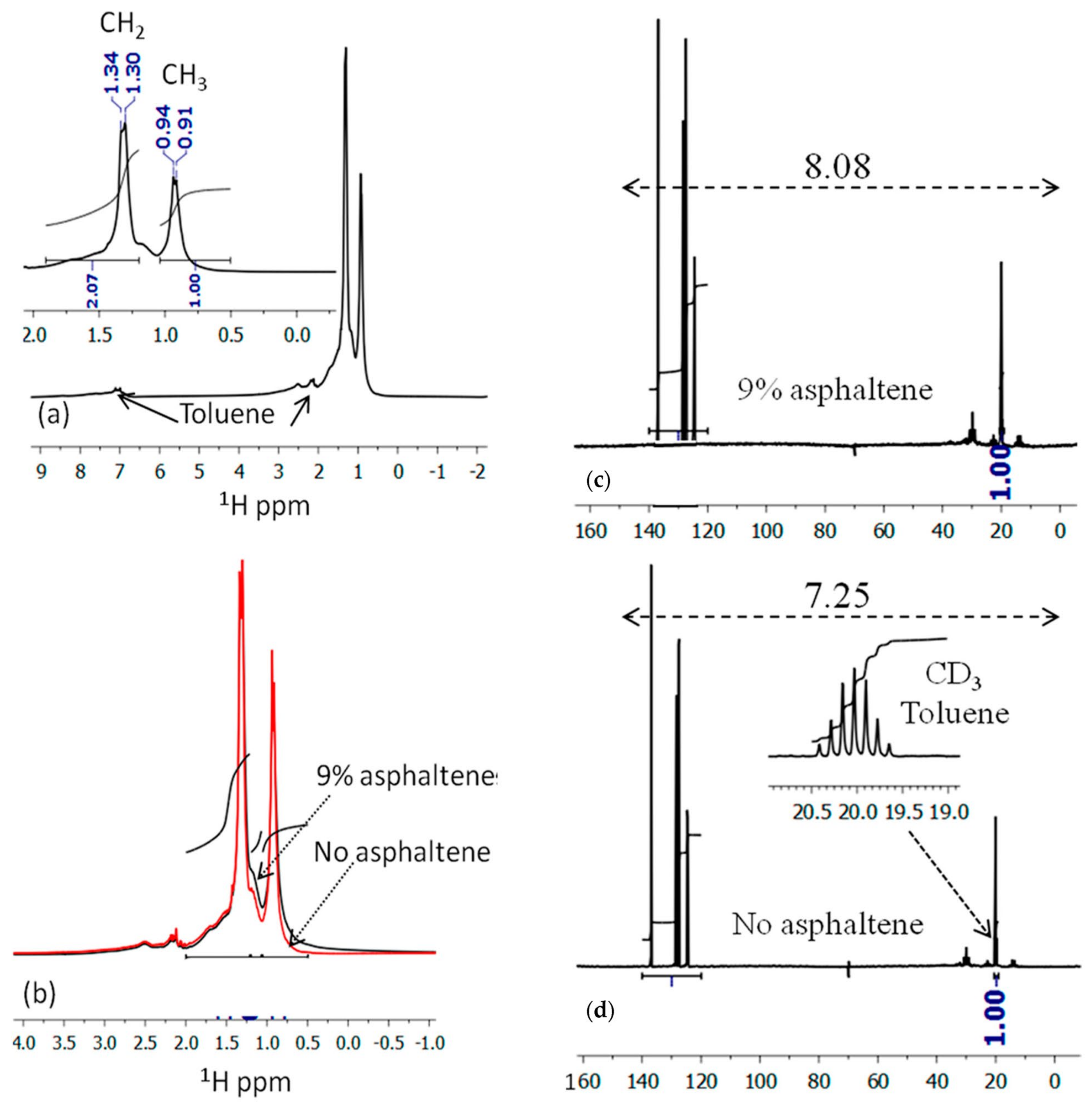
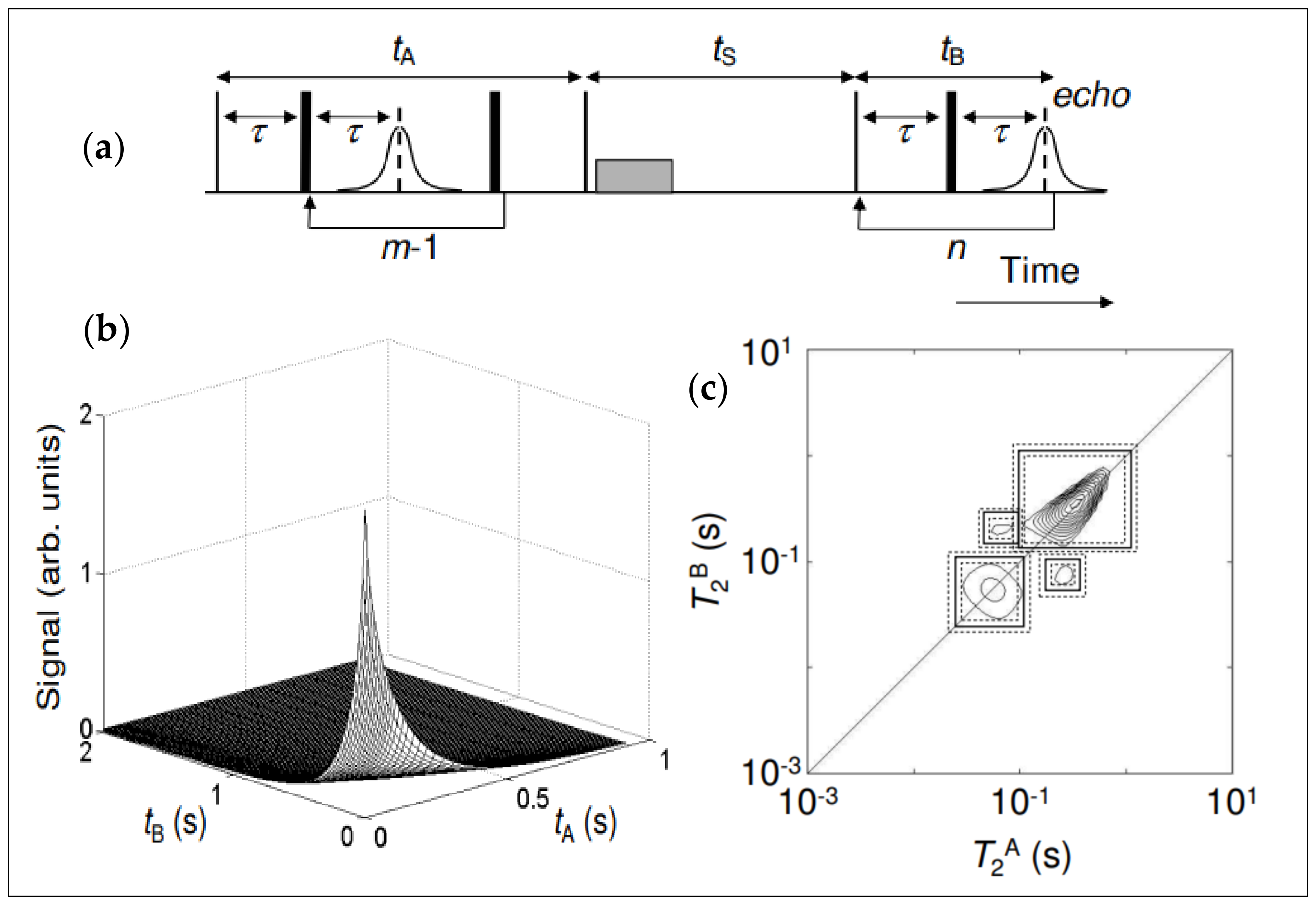

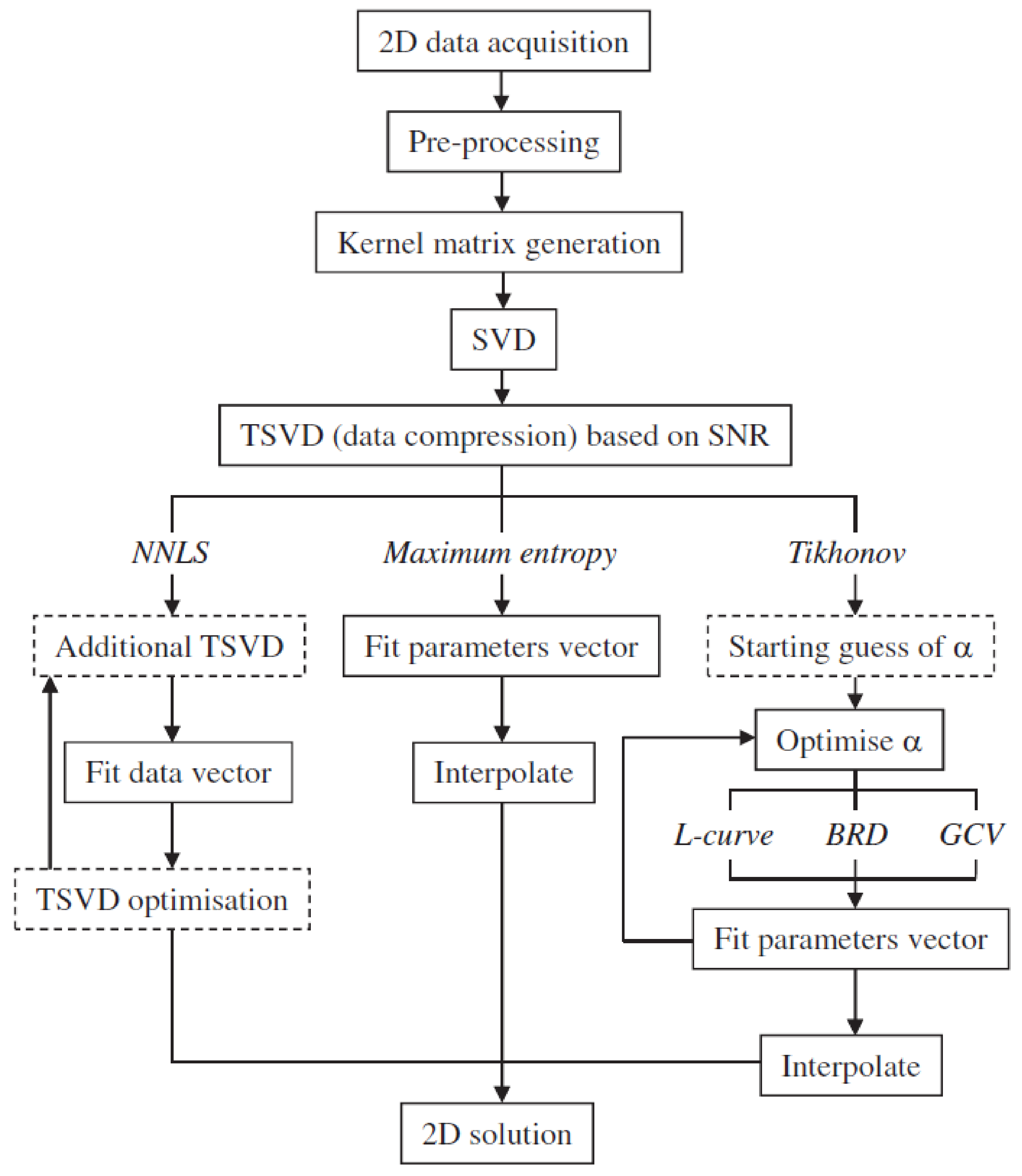

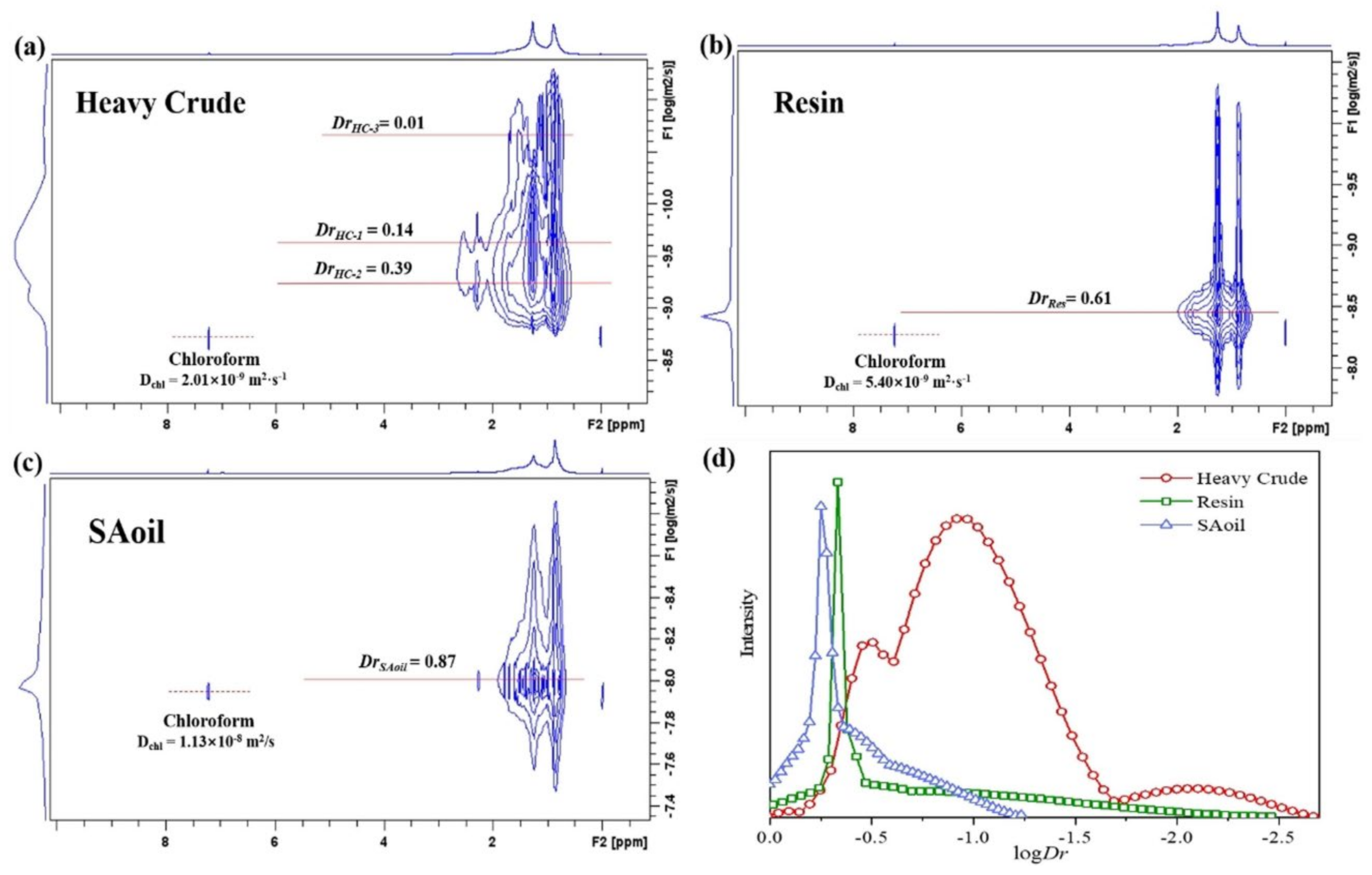
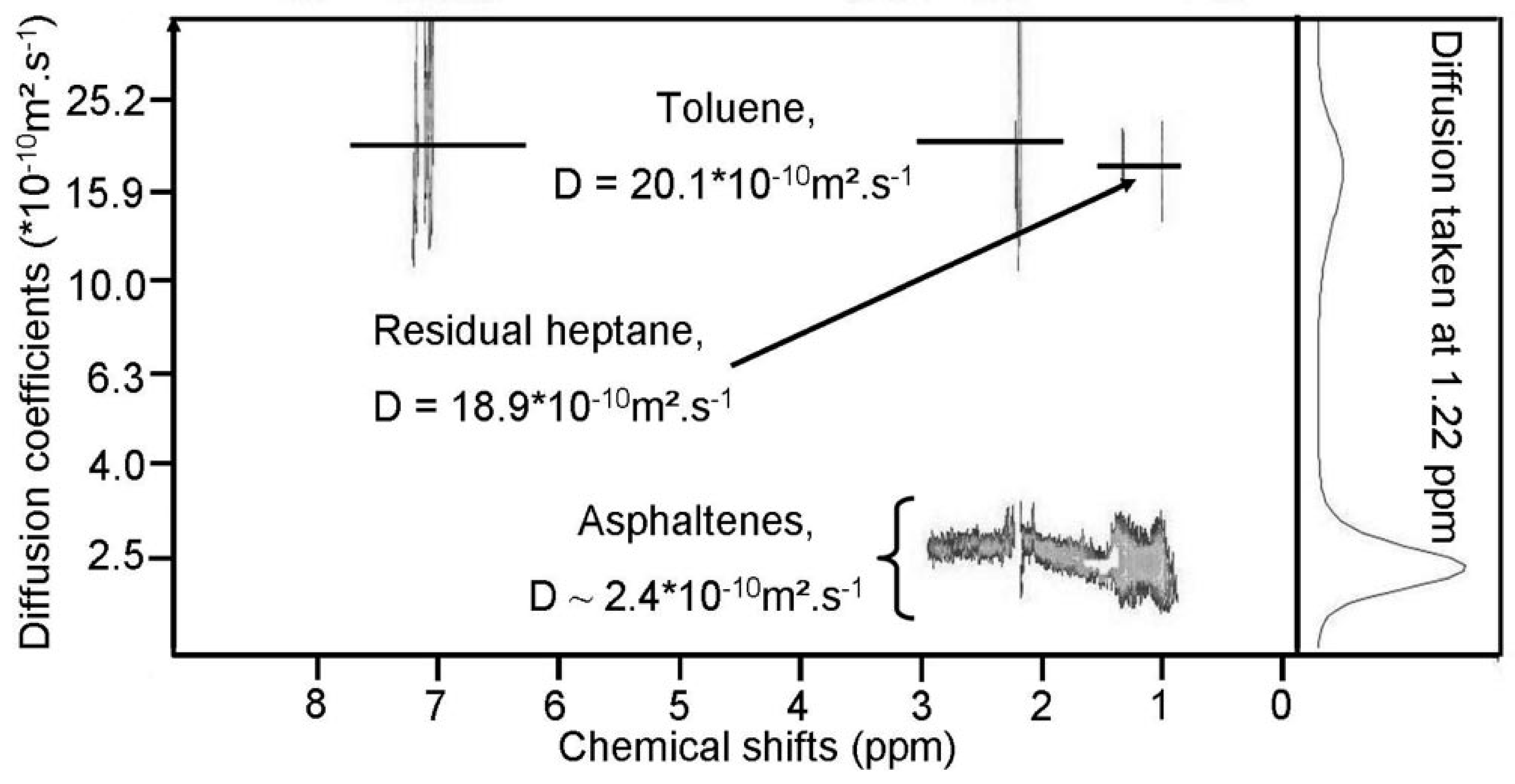
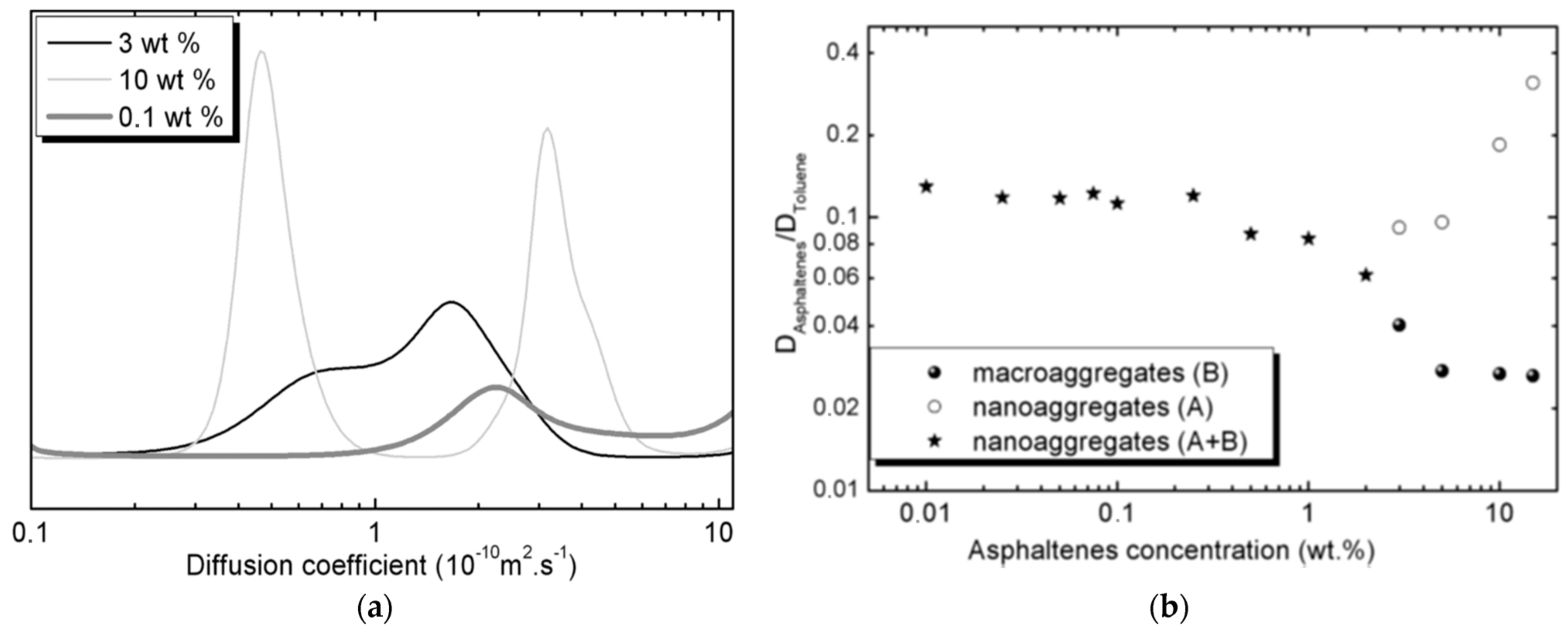
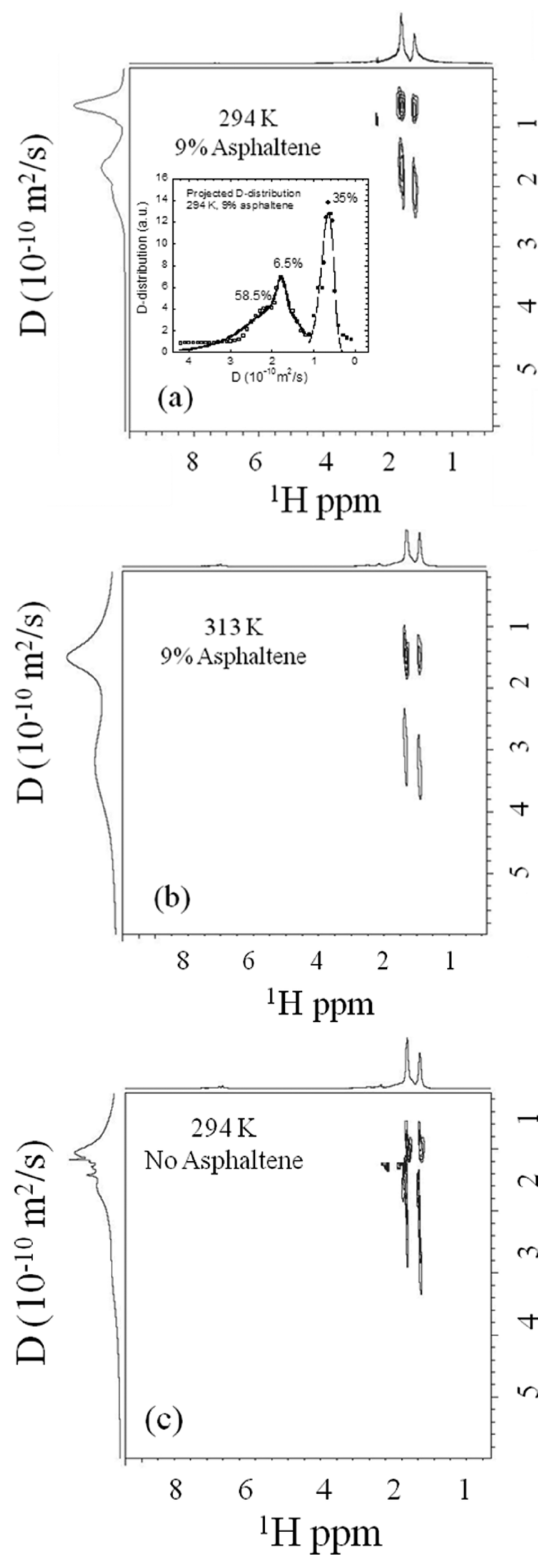
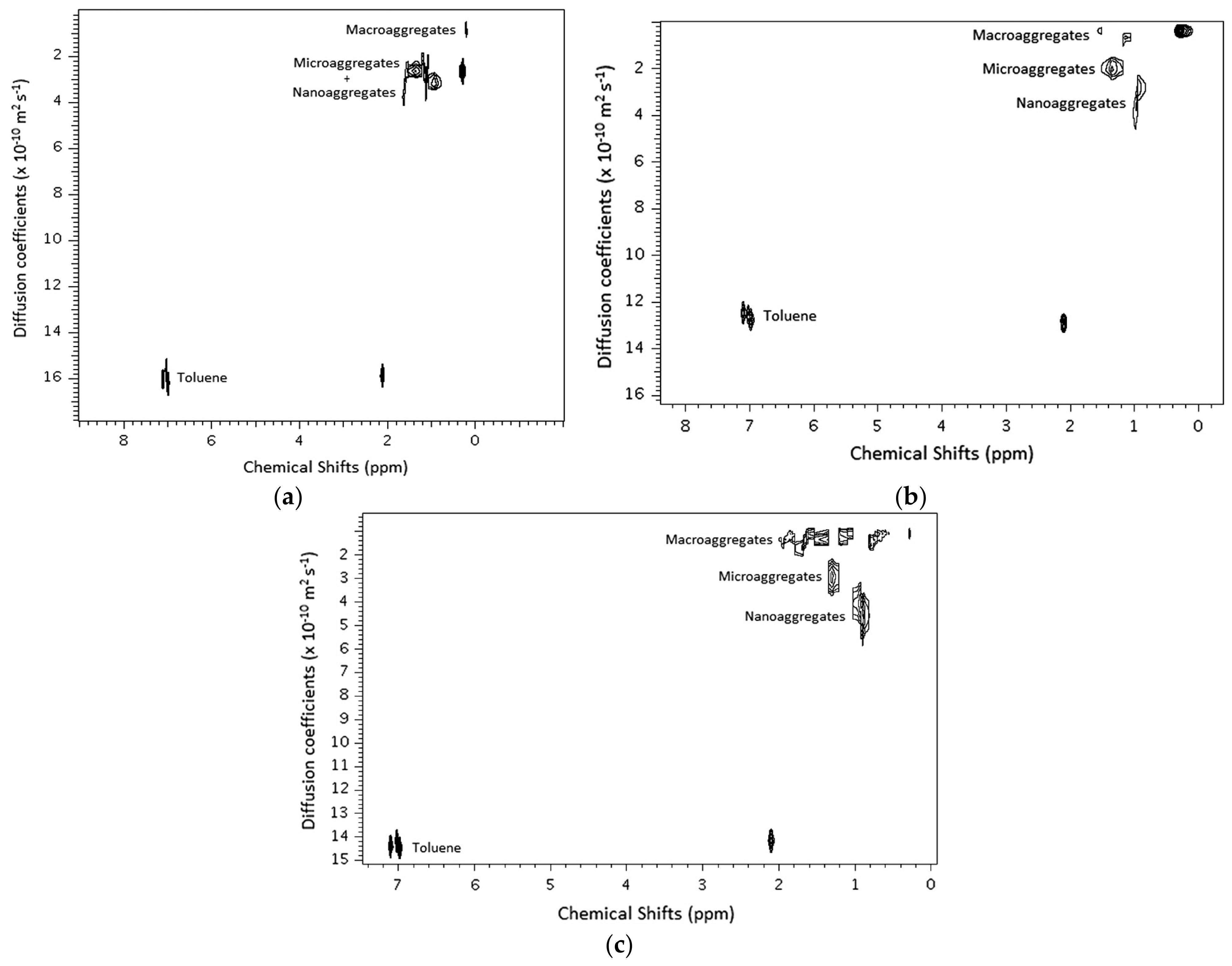
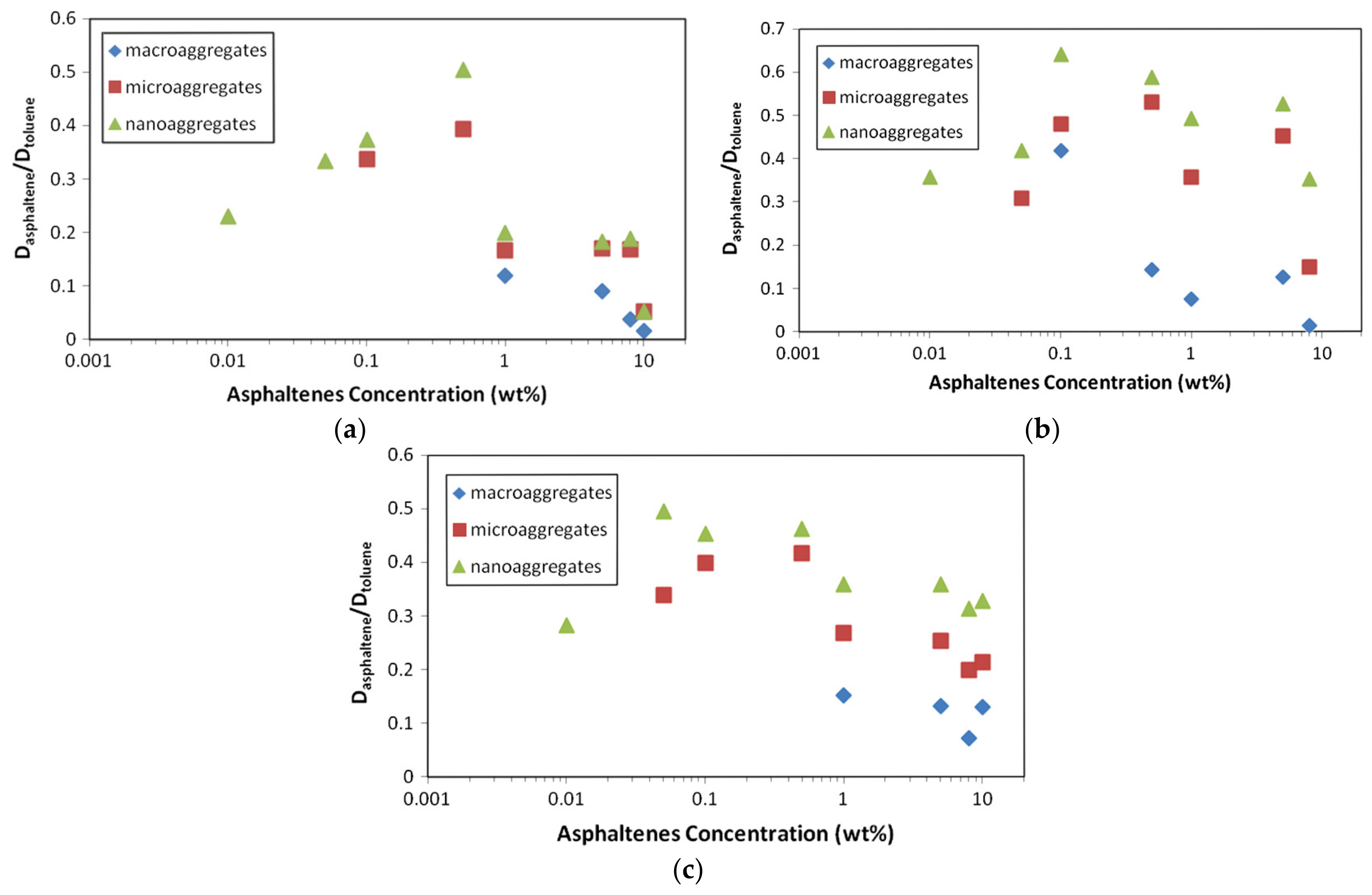



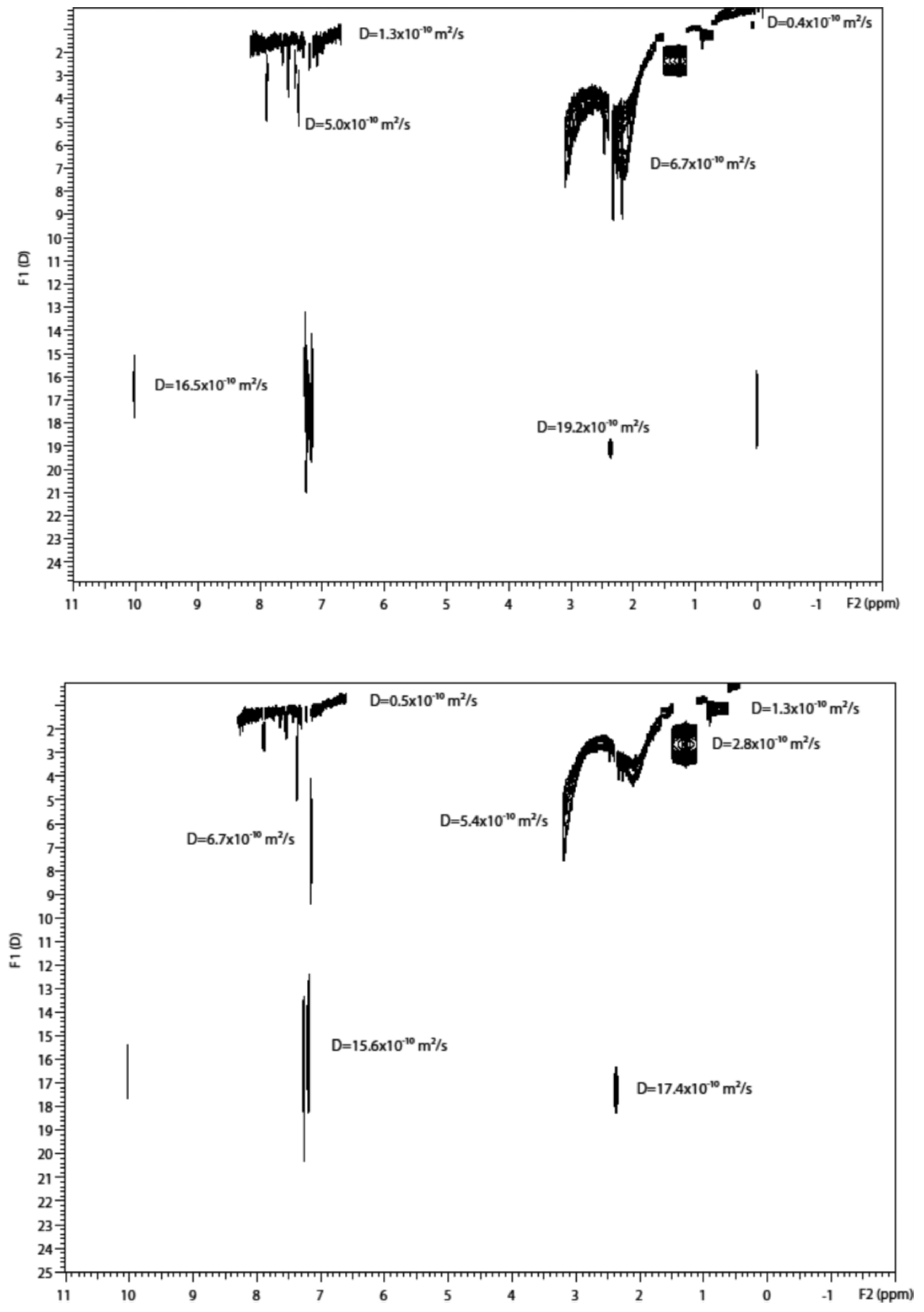

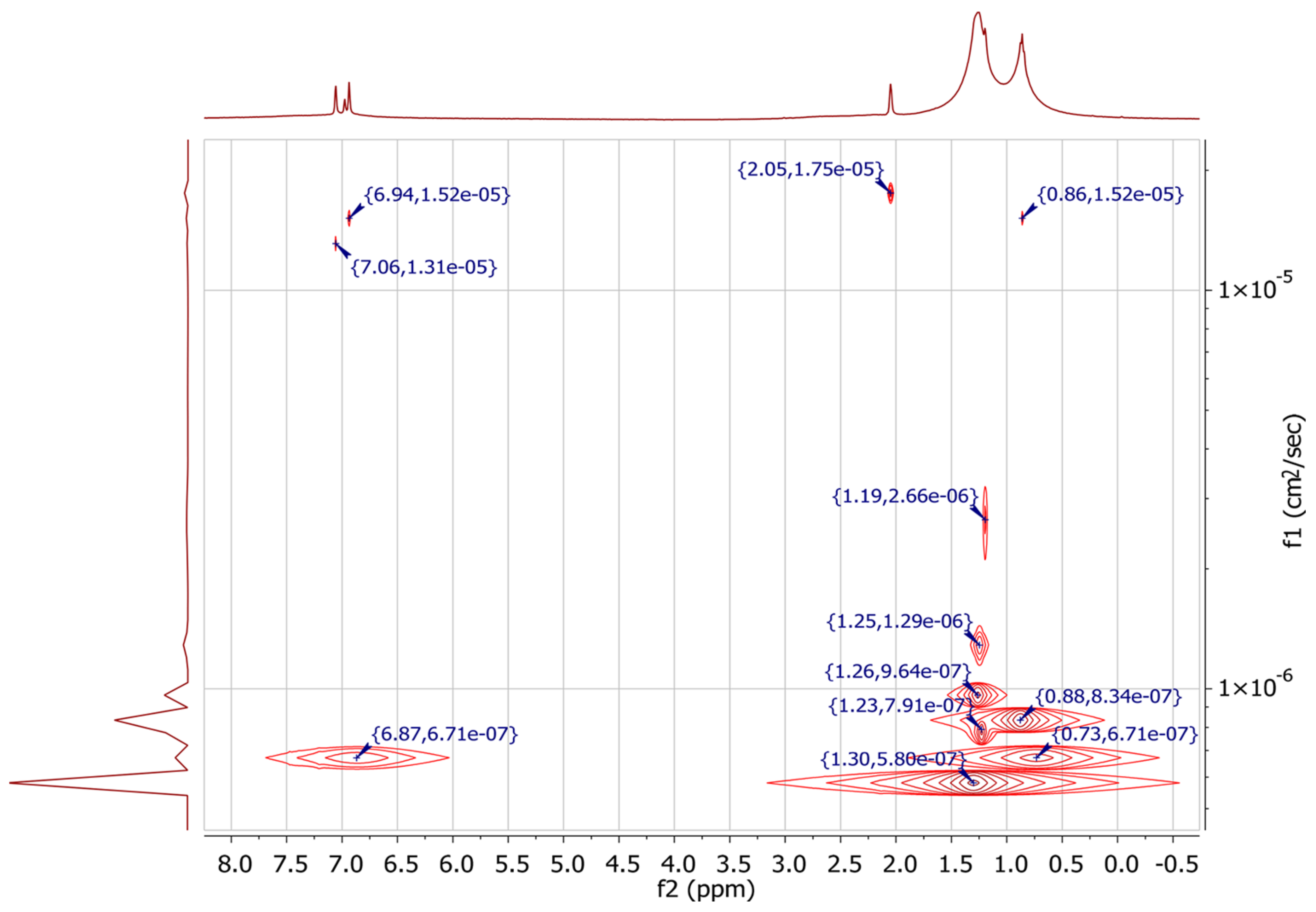
| Measurements | Applications | References |
|---|---|---|
| T1-T2 maps | Fluid-surface interaction | [72] |
| Dynamics of asphaltene aggregates in crude oil | [69] | |
| T1-T2 correlation with viscosity η of bulk heavy crude oils | [73] | |
| Fluid typing | [74] | |
| Permeability | [75] | |
| Wettability | [76,77] | |
| Heavy oil reservoir evaluation | [78] | |
| T2-Diffusion | Surface relaxivity (S/V ratio) | [79] |
| Wettability | [80,81,82] | |
| Fluid saturation | [83] | |
| T2-store-T2 | Pore coupling | [84] |
| Asphaltene deposition | [85] | |
| Diffusion exchange | [86] |
Disclaimer/Publisher’s Note: The statements, opinions and data contained in all publications are solely those of the individual author(s) and contributor(s) and not of MDPI and/or the editor(s). MDPI and/or the editor(s) disclaim responsibility for any injury to people or property resulting from any ideas, methods, instructions or products referred to in the content. |
© 2024 by the authors. Licensee MDPI, Basel, Switzerland. This article is an open access article distributed under the terms and conditions of the Creative Commons Attribution (CC BY) license (https://creativecommons.org/licenses/by/4.0/).
Share and Cite
Shaikhah, D.; Oliviero Rossi, C.; Luca, G.D.; Angelico, R.; Calandra, P.; Caputo, P. The Use of Nuclear Magnetic Resonance Spectroscopy (NMR) to Characterize Bitumen Used in the Road Pavements Industry: A Review. Molecules 2024, 29, 4038. https://doi.org/10.3390/molecules29174038
Shaikhah D, Oliviero Rossi C, Luca GD, Angelico R, Calandra P, Caputo P. The Use of Nuclear Magnetic Resonance Spectroscopy (NMR) to Characterize Bitumen Used in the Road Pavements Industry: A Review. Molecules. 2024; 29(17):4038. https://doi.org/10.3390/molecules29174038
Chicago/Turabian StyleShaikhah, Dilshad, Cesare Oliviero Rossi, Giuseppina De Luca, Ruggero Angelico, Pietro Calandra, and Paolino Caputo. 2024. "The Use of Nuclear Magnetic Resonance Spectroscopy (NMR) to Characterize Bitumen Used in the Road Pavements Industry: A Review" Molecules 29, no. 17: 4038. https://doi.org/10.3390/molecules29174038
APA StyleShaikhah, D., Oliviero Rossi, C., Luca, G. D., Angelico, R., Calandra, P., & Caputo, P. (2024). The Use of Nuclear Magnetic Resonance Spectroscopy (NMR) to Characterize Bitumen Used in the Road Pavements Industry: A Review. Molecules, 29(17), 4038. https://doi.org/10.3390/molecules29174038









